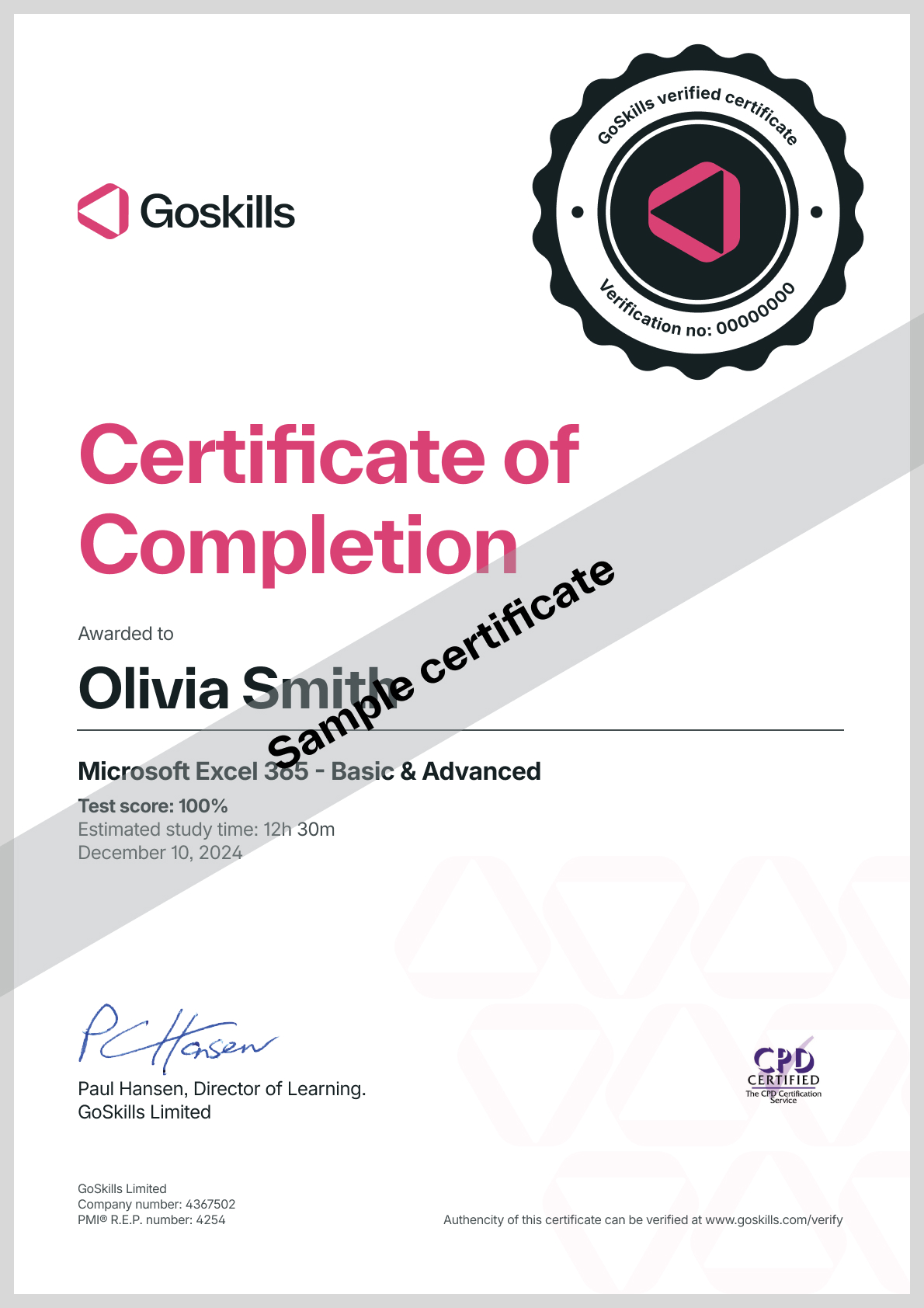Excel for Business Analysts
Excel for Business Analysts
Skills you’ll gain
Upgrade your Excel skills by learning how to capture data-driven insights with the GoSkills Excel for Business Analysts course.
This intermediate-level course builds on the basics, introducing the concepts and features professionals need to better understand and develop their business. By the end of this course, you’ll know how to optimize your data and create eye-catching tables, charts, dashboards, and more.
If you want to use Excel to better manage statistics and provide important predictions for the future — like the success of marketing campaigns or sales and inventory tracking — this course is for you!
In a series of bite-sized lessons, you’ll learn how to:
- Create better spreadsheets using data validation, cell linking, and worksheet/workbook/cell protection.
- Use lookups and lists for data cleanup and advanced analysis.
- Import and prepare data from multiple sources, such as online and hard copies.
- Build a pivot table from multiple data sources using Power Pivot.
- Produce beautiful charts and diagrams to present your data.
- Share data effectively with Dashboards.
- Use forecasting and Excel’s What-If Analysis to predict outcomes.
Previous experience in Excel is recommended, so if you're new to Excel, we recommend starting with our Excel Basics & Advanced course. Already a pro? Then you'll learn some new tricks and powerful tools to harness Excel for business analytics.
Once enrolled, our friendly support team and tutors are here to help with any course-related inquiries.
Syllabus
Download syllabus-
1
The Golden Rules of Spreadsheet Design Explore the golden rules when it comes to designing and organizing spreadsheets effectively. 7m
-
2
Naming Conventions and Version Control Explore how to standardize file, tab, table and chart naming conventions as well as how to implement a basic version control system. 8m
-
3
Give Instruction with Summary Sheets Create a summary sheet for the workbook to let others know how the spreadsheet should be used and managed. 5m
-
4
Use Color and Cell Styles to Assist with Organization Learn how to use color and pre-defined cell styles to add structure to the spreadsheet. 8m
-
5
Methods to Minimize Spreadsheet Errors: Part 1 - Cell Linking Explore some of the methods available in Excel to cut down on the amount of input errors and protect important formulas. 7m
-
6
Methods to Minimize Spreadsheet Errors: Part 2 - Data Validation Data Validation helps us control what information is going into the spreadsheet. 9m
-
7
Methods to Minimize Spreadsheet Errors: Part 3 - Protection Learn how to apply protection at the workbook, worksheet, and cell level to prevent unwanted changes. 4m
-
1
Lookup Information with Duplicate Lookup Values Use VLOOKUP to find information in a table when the lookup value is duplicated. 8m
-
2
Perform Complex Lookups with INDEX, MATCH and Data Validation Lists Create a Data Validation List and use it to perform a flexible lookup using INDEX and MATCH. 8m
-
3
Two-Way Lookups with INDEX and MATCH or XLOOKUP Utilize INDEX and MATCH or XLOOKUP (Microsoft 365, 2019, 2021) to perform a lookup with two criteria. 6m
-
1
Compare Lists with Formatting Learn how to compare two lists and highlight differences using formatting. 4m
-
2
Compare Lists with FILTER, COUNTIF and NOT Explore one of the newer functions in Excel, FILTER, and learn how to use it with COUNTIF to compare two lists. 5m
-
3
Compare Lists with VLOOKUP, VSTACK and UNIQUE Use the UNIQUE function to return duplicate values from two lists. 5m
-
4
Highlight Rows in a List with Conditional Formatting and Data Validation Create a new conditional formatting rule using a formula that highlights the row if a duplicate is found. 6m
-
5
Create Multiple, Dependent Data Validation Lists Create multiple data validation drop-down lists that change depending on the selection in the previous list. 7m
-
6
Create Dynamic Checklists Create interactive, dynamic checkboxes that harness the power of form controls and conditional formatting. 6m
-
7
5 Uses of Excel's 'Superhero' Flash Fill Learn the different ways Flash Fill can be used to combine, split and change items in Excel lists. 7m
-
1
Import Data from the Web Learn the quick and easy way to import data from the web. 5m
-
2
Combine Data with CONCAT and TEXTJOIN Explore how the CONCAT and TEXTJOIN functions can be used to combine data that's split across multiple columns. 8m
-
3
Methods for Splitting Data Explore the numerous methods in Excel for splitting data across multiple columns. 7m
-
4
Data Cleaning Techniques Tidy up data by removing erroneous spaces, random line-breaks and weird non-printing characters by combining 3 useful Excel text functions. 7m
-
5
New Text Manipulation Functions Take a first look at Excel's new set of functions for manipulating text. (Microsoft 365, Excel 2021 only) 8m
-
6
New Array Manipulation Functions Take a first look at Excel's new set of functions for manipulating arrays. (Microsoft 365, Excel 2021 only) 8m
-
1
Pivot Table Recap A quick recap on the basics of Pivot Tables. 7m
-
2
Advanced Pivot Table Tips and Tricks - Part 1 Explore advanced Pivot Table Tips and Tricks to supercharge your analysis skills. 4m
-
3
Advanced Pivot Table Tips and Tricks - Part 2 More advanced PivotTable Tips and Tricks to supercharge your analysis skills. 4m
-
4
Combine Multiple Data Sources with Power Pivot - Part 1 Got multiple datasets stored in different worksheets or workbooks that you want to analyze in one Pivot Table? If so, Power Pivot is your savior. 6m
-
5
Combine Multiple Data Sources with Power Pivot - Part 2 Let's continue our look at Power Pivot and how to combine multiple data sources. 4m
-
1
Choose the Right Chart Type Understand that not all charts are created equal and select the most appropriate chart type for your data. 7m
-
2
Create a Map Chart Learn how to create a gradient map chart using Pivot Table data. 3m
-
3
Create a Histogram Chart Create a histogram chart to display chart data grouped into bins. 7m
-
4
Advanced Chart Formatting Learn some advanced chart formatting techniques that tell the visual story of your data in a modern and effective way. 9m
-
5
Create SmartArt Diagrams Use SmartArt to quickly create flow charts and process diagrams. 7m
-
6
Create In-Cell Charts: Sparklines and Data Bars Represent values and trends in a cell using Sparklines and Data Bars. 7m
-
7
Create In-Cell Visualizations: The REPT Function Create in-cell visualizations using the REPT function. 6m
-
1
What is an Interactive Dashboard? Understand what a dashboard is and how you should prepare before creating a dashboard. 4m
-
2
Create and Format Multiple Pivot Tables and Pivot Charts: Part 1 Create multiple Pivot Tables and Pivot Charts to display key metrics that are of important to your audience. 6m
-
3
Create and Format Multiple Pivot Tables and Pivot Charts: Part 2 Continue learning about how to use Pivot Tables and Pivot Charts to display key metrics. 5m
-
4
Prepare a Calculations Sheet Create a calculations worksheet and use formulas to extract dashboard information from the source data. 9m
-
5
Dashboard Design Use formatting techniques to design a branded, consistent looking dashboard. 5m
-
6
Bring it all Together and Keep Information Updated Bring all charts and calculations together on the dashboard and understand how to keep the dashboard updated when new data is added to the source. 8m
-
1
Create a Linear Forecast with Forecast Functions Understand how forecasting works and how to forecast data into the future using Excel functions. 6m
-
2
Create a Seasonal Forecast with Forecast Functions Learn how to create a seasonal forecast using forecast functions. 4m
-
3
Add Confidence Levels Calculate the upper and lower confidence bound. 4m
-
4
Quick Forecasts Create simple and quick forecasts using the Forecast Sheets utility. 5m
-
1
What-If Analysis: Goal Seek Start with a target value and work backwards to find what needs to change to achieve your goal. 7m
-
2
What-If Analysis: Scenario Manager Use Scenario Manager to see what your data will look like if conditions change. 8m
-
3
What-If Analysis: Data Tables Use Data Tables predict values based on a set of conditions. 7m
-
1
Course Close Course wrap up, review and goodbyes. 6m
Certificate
Certificate of Completion
Awarded upon successful completion of the course.

Instructor
Deborah Ashby
Deborah is a Microsoft MVP and TAP Accredited Microsoft Instructor and Content Creator specializing in the design and development of online training courses and video content.
Since the mid-1990s, she has been involved in the IT industry, starting her career on an IT Helpdesk for an airline at the tender age of 16. This sparked a passion for travel, and in 1997, she left the U.K. and moved to Melbourne, Australia, where she furthered her career as an Operations Analyst and programmer.

Deborah Ashby
Microsoft MVP and Trainer
Accreditations
Link to awardsHow GoSkills helped Chris
I got the promotion largely because of the skills I could develop, thanks to the GoSkills courses I took. I set aside at least 30 minutes daily to invest in myself and my professional growth. Seeing how much this has helped me become a more efficient employee is a big motivation.


